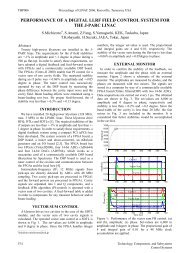Design and Development of a Diagnostics Client for a Beam Loss ...
Design and Development of a Diagnostics Client for a Beam Loss ...
Design and Development of a Diagnostics Client for a Beam Loss ...
You also want an ePaper? Increase the reach of your titles
YUMPU automatically turns print PDFs into web optimized ePapers that Google loves.
<strong>Design</strong> <strong>and</strong> <strong>Development</strong> <strong>of</strong> a <strong>Diagnostics</strong> <strong>Client</strong> <strong>for</strong> a <strong>Beam</strong> <strong>Loss</strong> Measurement System at CERN<br />
• Comm<strong>and</strong>ing the server. After establishing a connection with the server, the client<br />
should be able to send a comm<strong>and</strong> packet. There are two types <strong>of</strong> comm<strong>and</strong>s in<br />
the system. The first group <strong>of</strong> comm<strong>and</strong>s contains details <strong>of</strong> the acquisition request.<br />
There are also expert comm<strong>and</strong>s which can be sent to the server in order to set its<br />
internal registers. At this point a protocol <strong>for</strong> the comm<strong>and</strong>ing should be designed.<br />
The client’s logic implements this feature. The protocol <strong>and</strong> the description <strong>of</strong> all<br />
the types <strong>of</strong> comm<strong>and</strong>s (Acquisition, Expert <strong>and</strong> Advanced) is presented in Chapter<br />
4.3.1. Furthermore, the description <strong>and</strong> implementation <strong>of</strong> the Expert <strong>and</strong> Advanced<br />
comm<strong>and</strong>s is explained thoroughly in Chapters 4.4.6 <strong>and</strong> 4.4.6.1.<br />
• Data sorting <strong>and</strong> processing. The server can send both mixed acquisition <strong>and</strong> sta-<br />
tus/diagnostic data. The protocol should be designed so the data type can be dis-<br />
tinguished <strong>and</strong> processed accordingly.<br />
In Chapter 4.4.3, we explain the internal distribution process <strong>of</strong> the two data types.<br />
The acquisition, distribution <strong>and</strong> processing <strong>of</strong> the data is done by three different<br />
threads <strong>for</strong> better per<strong>for</strong>mance.<br />
• Displaying in real time two different types <strong>of</strong> data, acquisition <strong>and</strong>/or status, <strong>for</strong> di-<br />
agnostics purposes. This is the main function <strong>of</strong> the application <strong>and</strong> the final goal <strong>of</strong><br />
the development process.<br />
The online acquisition tab <strong>and</strong> more precisely the graph component inside it is used<br />
<strong>for</strong> displaying the acquisition data in real-time. The status data tabs are used <strong>for</strong> dis-<br />
playing the status elements in parallel with the acquisition data. The refresh rate <strong>of</strong><br />
the data in the graphs inside the status tabs is always 1 Hz. For the online graph, the<br />
refresh rate depends always on the measurement period field, but the user should<br />
be careful with this value, because a small measurement period could cause per<strong>for</strong>-<br />
mance issues.<br />
We can examine in the following figures, some real-time data coming from a BLEDP<br />
server in the Proton Synchrotron (PS) accelerator facility. Different detectors are<br />
connected in the input <strong>of</strong> some channels <strong>of</strong> that system. All the following figures<br />
were captured during an online data transmission.<br />
Figures 33, 34 <strong>and</strong> 35 illustrate the real-time data-viewing <strong>of</strong> the two different types <strong>of</strong><br />
data, distributed in three tabs, from a single-channel acquisition with a measurement<br />
period <strong>of</strong> 10000 μs. The type <strong>of</strong> detector in the acquisition channel <strong>of</strong> this example<br />
is an ionization chamber.<br />
In Figure 33, the averaged acquisition data plot in the online display is shown. The<br />
observable peaks indicate beam losses produced by the connected detector in chan-<br />
nel 5. Obviously, the different components used <strong>for</strong> settings manipulation are dis-<br />
abled during an online session. Only the stop button <strong>and</strong> the Min-Max checkbox are<br />
enabled. Similarly, from the same acquisition, Figures 34 <strong>and</strong> 35 illustrate the status<br />
Emmanouil I. Angelogiannopoulos 49















